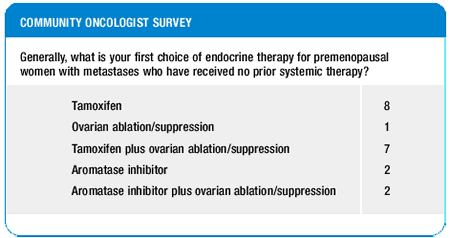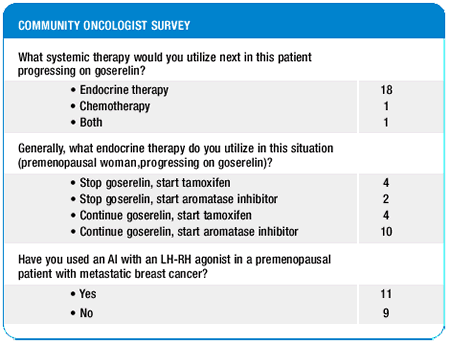| You
are here: Home: BCU 6|2001: Section 2

FIRST-LINE ENDOCRINE THERAPY OF PREMENOPAUSAL WOMEN
The question of whether tamoxifen is superior, equivalent or inferior
to GnRH agonists is sort of unanswerable. This patient’s family
thrombosis history aside, my inclination in general is to use GnRH
analogs, because they assure compliance. Using hormonal therapies
in sequence is the best way to treat estrogen-sensitive breast cancer.
Leuprolide or goserelin followed by tamoxifen always made more sense
to me than the opposite.
There are two clinical trials that compared goserelin plus tamoxifen
to tamoxifen alone, and there was a pooled analysis of the two studies
40-42. The rates of response with combination therapy are generally
higher but so are the toxicities. The survival rates might also
be slightly longer with the combination, but we don’t know
what sequence of hormonal therapies the control groups received.
I would submit that if someone did a pure endocrine study of Drug
A plus Drug B versus Drug A followed by Drug B, you probably wouldn’t
see a significant difference in outcome. The second arm of that
study — Drug A followed by Drug B — is virtually guaranteed
to have less toxicity. Based on the available information, I still
have not jumped into the combined hormonal therapy camp.
—Kevin Fox, MD
Tamoxifen would usually be my first-line hormonal intervention
in a premenopausal woman with metastatic disease. In this case,
the family history of pulmonary emboli would give me pause. Although
her family history raises a red flag, because her coagulation workup
was negative, in my opinion tamoxifen is not contraindicated.
—Patricia Madej, MD
Based on the first-line data of AIs versus tamoxifen in metastatic
breast cancer 43-45, my strategy would be to suppress ovarian function
and put her on an AI rather than to use tamoxifen, because I think
these agents work better for metastatic disease. Ovarian suppression
can be done with an LH-RH agonist or oophorectomy — that’s
up to each individual patient. Younger women often don’t want
immediate oophorectomy — I think that an LH-RH agonist is a
good way to bridge the gap.
—Stephen Jones, MD

|
Case history continued:
After 26 months on goserelin, both the breast mass and pulmonary
nodules increased in size. The patient was treated with goserelin
and anastrozole and again responded, this time for 28 months.
|

CHOOSING ANOTHER ENDOCRINE THERAPY
I chose anastrozole in this case because of the patient’s
family history of pulmonary emboli in two siblings. I worked her
up for a thrombophilia and found none of the common causes. But,
in this patient with an undefinable propensity towards thrombosis
based on a family history, I thought it most prudent to prescribe
the least thrombogenic hormonal therapy compared to tamoxifen —
in this case, anastrozole 46-48.
—Kevin Fox , MD
In this particular scenario, I would consider another hormonal
intervention. She’s clearly shown a response clinically for
a significant duration, so another hormonal intervention could be
considered. Probably at this point, our next step would be to add
an aromatase inhibitor. They are well-tolerated, and there is measurable
efficacy in hormone receptor-positive patients.
—Patricia Madej, MD
Page
4 of 6
Previous
page | Next page
|
